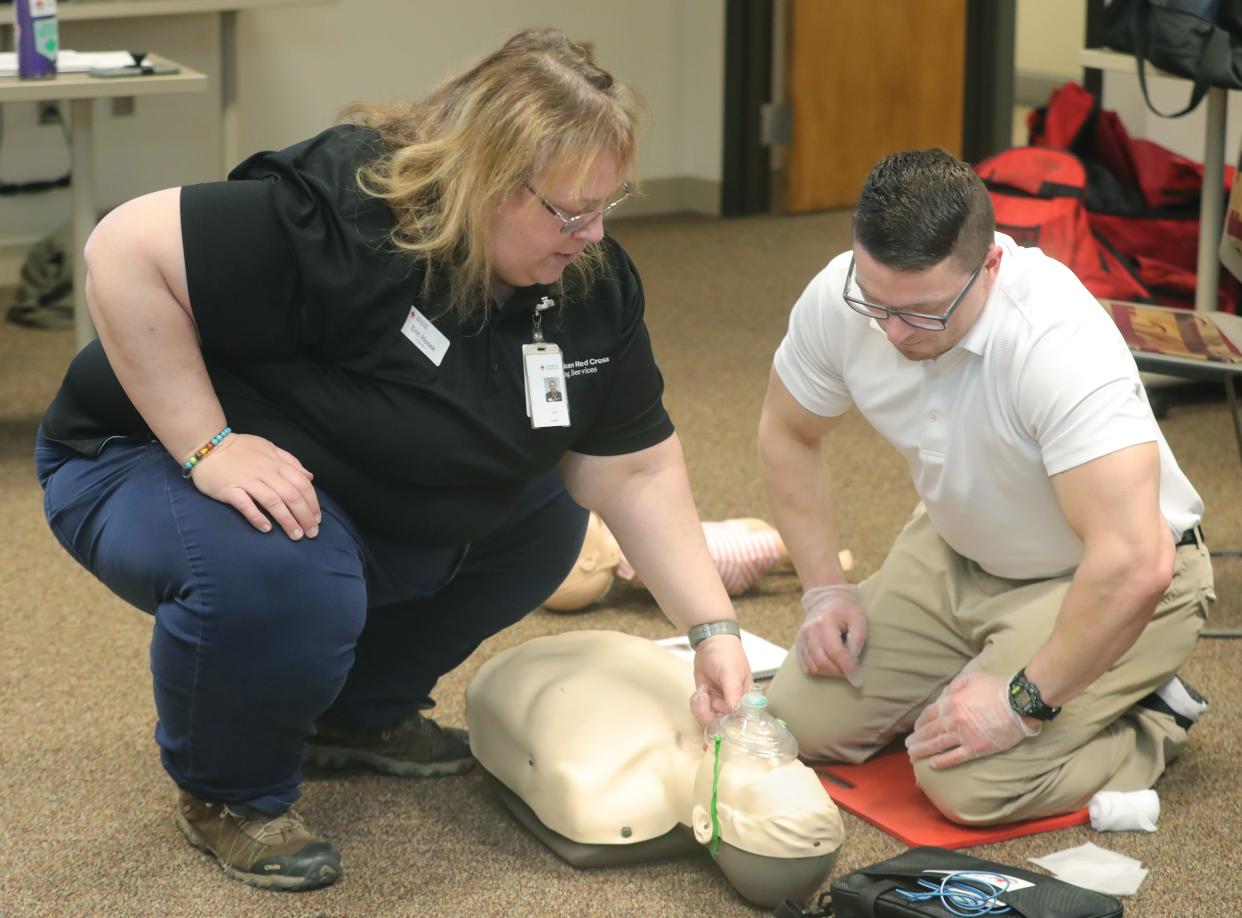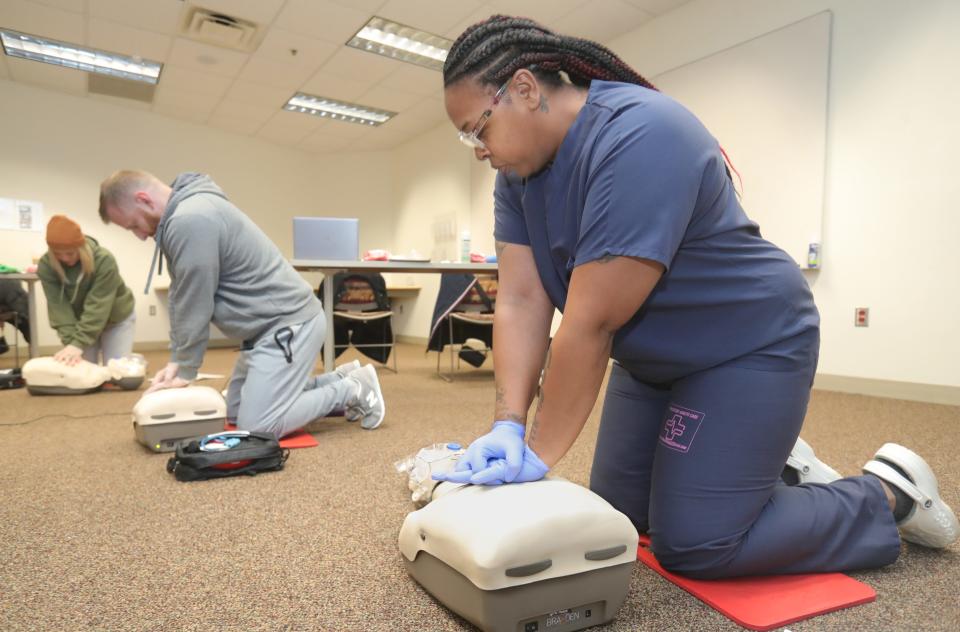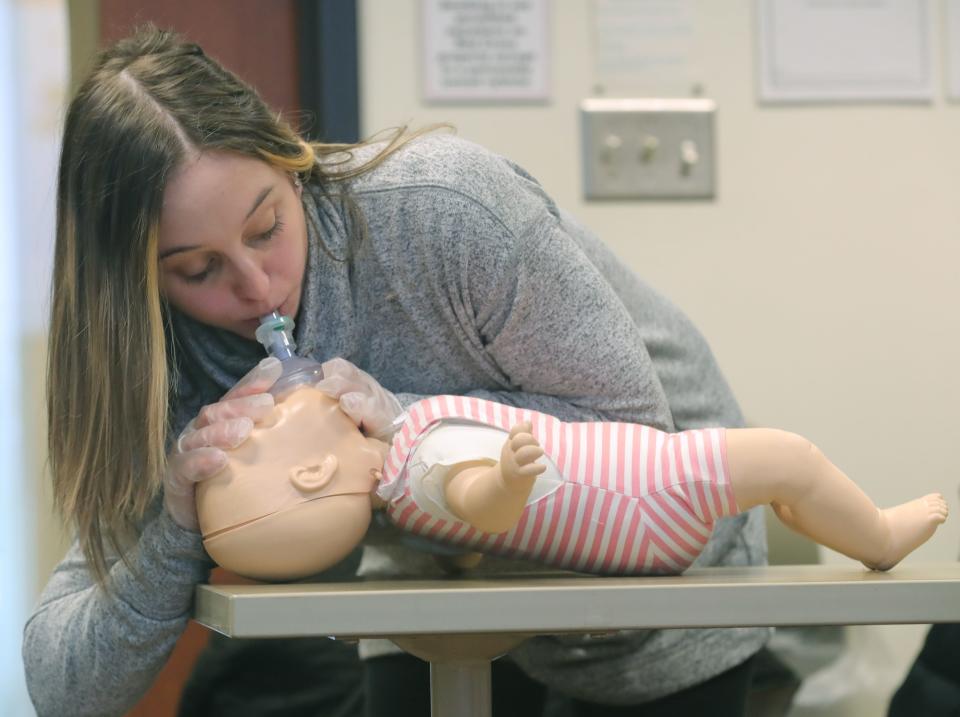How to save a life: Frightening NFL moment drives up interest in learning CPR

- Oops!Something went wrong.Please try again later.
Sports fans everywhere gasped when the Buffalo Bills' Damar Hamlin suffered cardiac arrest on the field during a Jan. 2 game against the Cincinnati Bengals.
They sighed in relief at his remarkable recovery — which doctors said could not have been possible without a lifesaving technique applied at the scene.
And a national conversation arose as people asked themselves, "What if that happened to somebody in my life?"
“If you are called on to give CPR in an emergency, you will most likely be trying to save the life of a loved one: a spouse, a parent, grandparent, child or a friend,” said Dr. Michelle A. Albert, president of the American Heart Association. The organization, which celebrates February as American Heart Month, has seen interest in its resources soar.
The American Heart Association said that in the days that followed Hamlin's collapse, its website saw:
Aa 620% increase in page views to hands-only CPR pages.
A 145% increase in traffic to the "What is CPR?" page.
A 113% increase in views of its CPR course catalog.
Hamlin has since launched a #3forHeart CPR Challenge aimed at saving more lives through CPR education and training with the American Heart Association.
Hamlin’s #3forHeart CPR Challenge is a social media challenge that asks people to do three things:
Learn: Go to heart.org/3 to watch a 60-second video to learn hands-only CPR.
Give: Donate to the American Heart Association to fund CPR training and other lifesaving programs and scientific research.
Share: Use #3forHeart to challenge three friends to do the same on social media.
To kick off the campaign, Hamlin challenged NBA legend LeBron James, now-retired quarterback Tom Brady and former first lady Michelle Obama.
'It's a sigh of relief':Browns players elated Damar Hamlin spoke to Bills in team meeting
CPR has saved lives locally

While Hamlin's experience grabbed global headlines, CPR education is a nonstop effort that continues to make a difference here in Northeast Ohio.
This past summer, Lindsey and Nicole Bechter were credited with saving the life of a woman while they were working at Clutch Lanes in Cuyahoga Falls. They will be honored by the American Red Cross, Northern Ohio Region in March, with an Acts of Courage Award on March 2.
Quick thinking saves life:Cuyahoga Falls salutes sisters for lifesaving aid on Clutch Lanes volleyball court
In addition, a Twinsburg officer was credited with saving the lives of not just one, but two people on the same shift. In July, Officer Olivia Bartulovic first went to a call at a business to perform CPR on a man in cardiac arrest. Later that evening, she was called to a residence, where a man had turned blue and had slid off his chair. Both were stabilized and transported to the hospital.
Rescue times two:Twinsburg officer performs CPR twice during same work shift
More recently, on Jan. 9, Streetsboro firefighters rushed to the aid of one of their own after Chris Fredmonsky collapsed at the fire station during an EMS training. As of Jan. 25, Fredmonsky is home and recovering, according to a social media post he made.
Emergency at the fire station:Streetsboro firefighter collapses during EMS training Monday, is hospitalized in ICU
Rapid response is crucial in medical emergencies

When a person has a cardiac arrest, survival depends on immediately receiving CPR and defibrillation from someone nearby. According to the American Heart Association, about 90% of people who suffer cardiac arrests outside of a hospital die. CPR, especially if performed immediately, can double, or triple a cardiac arrest victim’s chance of survival. However, bystanders only perform CPR 46% of the time.
"Sudden cardiac arrest can happen to anyone, anywhere and at any time without warning, but it usually occurs in adults," said Jim McIntyre, Northern Ohio regional communications director for the American Red Cross. "More than 300,000 people die of sudden cardiac arrest in the U.S. annually. For each minute that defibrillation is delayed, the person’s chance for survival is reduced by about 10%."
Cardiovascular disease remains the leading cause of the death in the United States. This year’s American Heart Month activities are designed to help motivate people to “Be the Beat” needed to keep someone alive by learning the two simple steps it takes to save a life — call 911 and push hard and fast in the center of the chest.
Hands-only CPR involves two simple steps that can be learned from a 60-second video available at heart.org/handsonlycpr.
The American Heart Association also has a list of songs — a 'Don't Drop the Beat' playlist — that are between 100 and 120 beats per minute, the same rate at which rescuers should perform compressions when administering CPR. Remembering songs such as “Stayin’ Alive,” by the Bee Gees, “Crazy in Love,” by Beyoncé featuring Jay-Z, “Hips Don’t Lie,” by Shakira” or “Walk the Line,” by Johnny Cash can help those administering chest compressions keep a steady rhythm.
For details, visit heart.org, or call 800-242-8721.
AED use also a valuable tool in saving lives
An automated external defibrillator, or AED, is a medical device that can restore a normal heart rhythm to someone who has gone into cardiac arrest.
As well as CPR, defibrillators have been credited in saving Hamlin's life.
Receiving immediate CPR and an electric shock from a defibrillator are the key drivers of survival for the roughly 350,000 U.S. adults who go into cardiac arrest outside of a hospital each year. However, according to information from the American Heart Association, only around 1 in 10 people who have cardiac arrests in public get this type of help.
A defibrillator can be manual, used by trained health care personnel to deliver a shock, according to the American Heart Association. An AED also can be automated, available for anyone to use, with the device determining if a shock is needed.
Support local journalism:6 reasons why you should subscribe to the Akron Beacon Journal
Reporter April Helms can be reached at ahelms@thebeaconjournal.com
This article originally appeared on Akron Beacon Journal: CPR awareness grows after Damar Hamlin's ordeal in NFL

